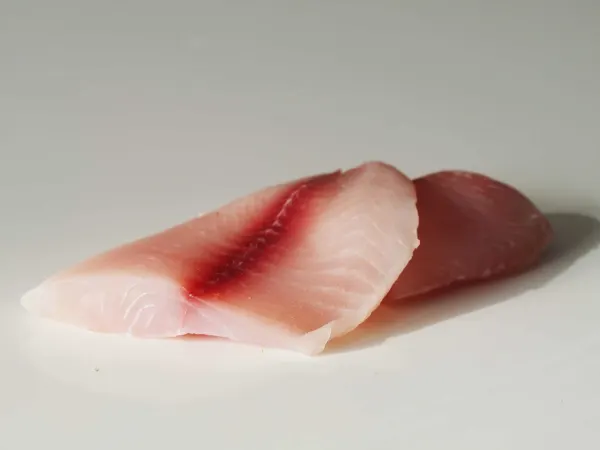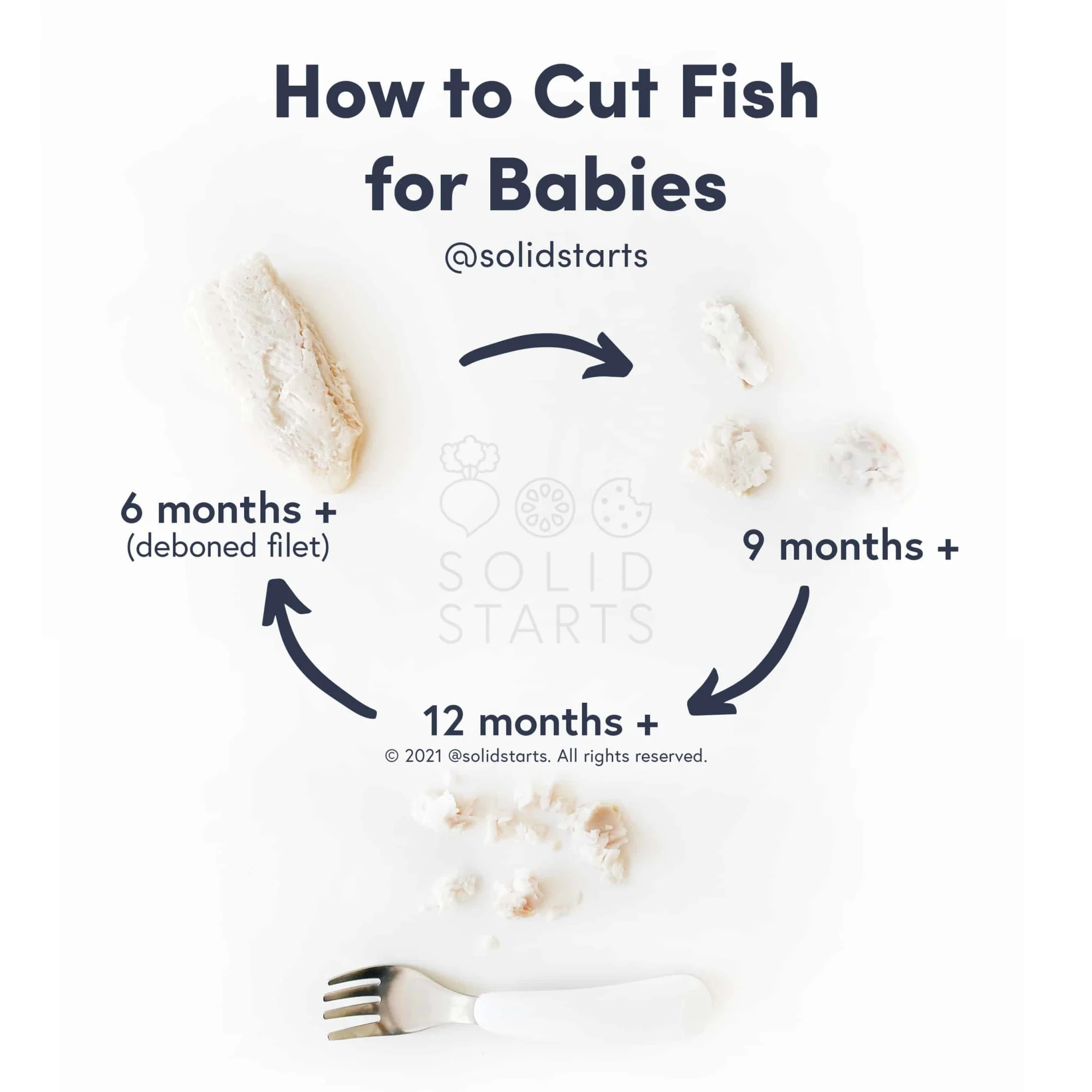Access our First Foods® Database in the Solid Starts App.
Learn moreTilapia
Fish
Age Suggestion
6 months
Iron-Rich
No
Common Allergen
Yes

When can babies eat tilapia?
Tilapia may be introduced as soon as baby is ready to start solids, which is generally around 6 months of age. Tilapia receives a “satisfactory” rating in our guide, Best & Worst Fish for Babies. Like most fish, tilapia contains trace amounts of methylmercury due to air pollution that settles into the ocean and binds to the flesh of fish. Compared to other fish, tilapia is relatively low in mercury and considered safe for babies around 1-2 times per week.
How do you prepare tilapia for babies with baby-led weaning?
Every baby develops on their own timeline, and the suggestions on how to cut or prepare particular foods are generalizations for a broad audience.
6 to 12 months old:
Introduce the fish by serving deboned, freshly cooked tilapia in sections about the size of two adult fingers together. Keep in mind that baby will likely smush the fish in their hand—this is okay. Alternatively, you can offer cooked, flaked tilapia mixed into soft, scoopable foods like Greek yogurt, mayonnaise, or hummus.
12 to 24 months old:
If you have the time and inclination, try homemade fish cakes by adapting our cod cakes recipe—just use tilapia in place of cod. For more advanced eaters, break cooked tilapia into flakes and pile high on buttered toast, or serve plain on a plate with a dollop of mayonnaise or tahini as finger food or fork practice. You can also continue to serve whole pieces or mashed fish as described above.
For a quick, easy-to-reference guide on the foods that deliver the nutrients babies need the most, see our Nutrition Cheat Sheet.
Videos
Is tilapia a common choking hazard for babies?
No. Tilapia is not a common choking hazard, though bones in fresh fish can present a risk if not removed. To minimize the risk, be sure to pick out any lingering bones before serving. As always, make sure you create a safe eating environment and stay within an arm’s reach of baby during meals. For more information on choking, visit our sections on gagging and choking and familiarize yourself with the list of common choking hazards.
Is tilapia a common allergen?
Yes. Finned fish are classified as a Global Priority Allergen by the World Health Organization. It is estimated that only 0.2 percent of people are allergic to finned fish worldwide, and the prevalence of fish allergies in children, while variable, is even less than in adults. About 40 percent of people with finned fish allergies don’t experience their first allergic reaction until adulthood. Unfortunately, most individuals who are allergic to finned fish do not outgrow the allergy.
Some individuals with finned fish allergy may react from inhaling airborne proteins that are aerosolized when cooking fish. If this is the case for baby, you may wish to avoid cooking fish in the household when baby is present.
Around 50% of individuals with one finned fish allergy will react to another fish as well. This is because the major allergen in finned fish, beta-parvalbumin, is present in most fish, regardless of species. Due to the risks of cross-contamination or mislabeling, allergists often recommend that those allergic to one species of finned fish avoid all finned fish until meeting with an allergist to determine which fish might be safely introduced into the diet. This is an individualized recommendation, so be sure to confirm with your allergist before offering other finned fish if baby is allergic to tilapia.
Finned fish are a known trigger of food protein-induced enterocolitis syndrome, also known as FPIES. FPIES is a delayed allergy to food protein which causes the sudden onset of repetitive vomiting and diarrhea to begin a few hours after ingestion. Left untreated, the reaction can result in significant dehydration. Unlike other food allergens, FPIES to finned fish may not present until later in life, and tends to be life-long.
Lastly, a note on scombroid poisoning, which is sometimes mistaken for a fish allergy. Scombroid poisoning is a type of food poisoning that occurs when someone eats fish that has been improperly refrigerated. This allows a large amount of histamine to build up in the fish. When consumed, this large load of histamine can cause symptoms that mimic those of an allergic reaction, causing some people to believe that they have developed a finned fish allergy, even if they are not allergic. Ensuring that fish has been stored at adequately cool temperatures can minimize the risk of such a reaction.
If you suspect baby may be allergic to fish, consult an allergist before introducing tilapia. As with all common allergens, introduce tilapia in small amounts at first and watch closely as baby eats to see if any adverse reaction occurs. If all goes well, gradually increase the serving size over time. Once common food allergens are successfully introduced, it is recommended to keep them in the diet regularly (twice weekly, if possible). However, this doesn’t mean that each different fish species must be offered multiple times a week - finned fish share the same major proteins, so it is perfectly acceptable to rotate finned fish varieties according to availability and preference.
Is tilapia healthy for babies?
Yes. The fish is low in mercury, high in protein, and packed with essential nutrients for growing babies. Of note, tilapia contains lots of vitamin B12, an important nutrient for brain development and healthy blood. It’s also high in selenium, which supports a healthy immune system, and can offer vitamin D, an important bone-building nutrient that can be hard to obtain from food sources.
While farmed tilapia lacks the omega-3 fatty acids that we like to see in fish for babies, it has a big advantage over many ocean fish: less mercury. Mercury is a persistent and progressive toxin to which babies are particularly susceptible. Thankfully there are lots of fish low in mercury, like tilapia, that babies can enjoy. Furthermore, fish offers nutrients that are particularly important for babies (such as vitamin D and selenium) that can be hard to find in other foods. To minimize exposure to mercury from fish, simply focus on those fish that are lowest in mercury and limit the amount and frequency of fish that have higher amounts of mercury. More on this topic in our guide, Best & Worst Fish for Babies.
★Tip: Try to avoid premade or processed fish cakes, patties, and sticks, as most are extremely high in sodium. To make your own at home, try our recipe for cod cakes and swap in a white fish of your choosing. For more on how much sodium babies can have, see our Sodium page.
How can tilapia affect baby's poop?
Tilapia isn’t generally thought of as a food that promotes pooping. That said, it can play an important role in healthy bowel movements as part of a balanced and varied diet. Diets featuring white meats like tilapia may promote the presence of beneficial bacteria, like Lactobacillus, which contributes to a healthy and diverse gut microbiome. Pooping patterns can vary significantly from child to child, so be sure to talk to your pediatric healthcare provider if you have concerns about baby’s pooping or digestive function.
What are tilapia and where do they live?
Tilapia is the common name for a sprawling group of white fish that live in freshwater lakes, lagoons, rivers, streams, and brackish coastal areas in warm regions of the world. Humans have been eating tilapia since ancient times in Southwest Asia and North Africa, where tilapia originated and held symbolic meaning for patriarchs, pharaohs, and philosophers alike. Also known as amnon, bolty, tlhapi, and trondro, tilapia is an excellent source of protein and nutrients, plus it’s highly adaptable—winning qualities in fish farming. In fact, tilapia is so easy to cultivate that it is now one of the world’s most farmed fishes, earning the nickname “aquatic chicken” because of its mild taste and ability to prosper on commercial plant feed in a variety of controlled conditions.
What are recipe ideas for cooking with tilapia?
Like other white fish, tilapia can be prepared in any number of ways: baked, boiled, deep-fried, pan-fried, or preserved by drying, fermenting, or salting. When cooked, its flesh firms up while maintaining flakiness and a mild, slightly sweet flavor. Tilapia is eaten worldwide, from India, where the fish is often poached with vegetables and spices to make nadan meen curry, to Ghana, where the whole fish can be marinated, grilled, and served with a starch like banku (fermented dough), plantains, or rice.
Written and reviewed by these specialists
E. Cerda, MSN, CNS, LDN
A. Gilbaugh, RD, CNSC
K. Grenawitzke, OTD, OTR/L, SCFES, IBCLC, CNT
S. Bajowala, MD, FAAAAI. Board-Certified Allergist & Immunologist (allergy section)
R. Ruiz, MD, FAAP. Board-Certified General Pediatrician & Pediatric Gastroenterologist
Expert Tips Delivered to Your Inbox
Sign up for weekly tips, recipes and more!
Copyright © 2025 • Solid Starts Inc


